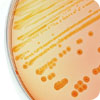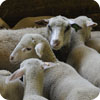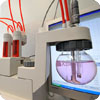M



10th International meeting on microbial epidemiological markers, October 2-5, 2013
S. Brisse, Pasteur Institute, Paris, France
I3S - International Symposium “Salmonella and Salmonellosis” 27-29 May 2013, Saint-Malo, France
G. Clément, ISPAIA - ZOOPOLE développement, Ploufragan, France.
An International Workshop in Paris: “New Trends on Analytical Methods for Pesticides and Drug Residues”
E. Verdon, ANSES - Fougères Laboratory, Fougères, France
XVIIIth WVPAC Congress in Nantes, 19-23 August 2013, France
G. Clément, ISPAIA - ZOOPOLE développement, Ploufragan, France
Guide from the EURL for Listeria monocytogenes
Publication of a guide on sampling in processing areas and equipment used in the production of foodstuffs with a view to detecting the presence of Listeria monocytogenes.
B. Carpentier, L. Barre, ANSES - Maisons-Alfort Laboratory for Food Safety, Maisons-Alfort, France
Building a dialogue between NRLs and French accredited laboratories ("peripheral laboratories")
B. Gouget, Anses - Scientific Department of Laboratories, Maisons-Alfort, France
Publication and design
Publication director: Marc Mortureux (France, ANSES) - Editor-in-chief: Paul Martin (France, ANSES) I Asistant managing editor: Barbara Gouget (France, ANSES) I Editorial board: Maria Laura Boschiroli (France, Anses), Didier Calavas (France, Anses), Sabine Delannoy (France, Anses), Bertrand Lombard (France, Anses), Jean-Yves Madec (France, Anses), Elisabeth Repérant (France, Anses), Christian Tricard (France, SCL), Eric Verdon (France, Anses)
Creation/Development: Lucie Lelyon (France, ANSES), Céline Leterq (France, ANSES), Parimage
Translation: Coup de Puce Expansion, Dana Pottratz (France, ANSES), Béatrice Vallantin (France, ANSES)
Photo credits: Anses, Ecole du Val de Grace, Inserm, Institut Robert Koch, INRA, Laboratoire Central de la Préfecture de Police, P. Latron
ISSN 2110-5294
We are pleased to bring you Issue No. 8 of EuroReference. After three years, we thought it important to take stock of this publication's existence. EuroReference has no less than 3000 subscribers and each issue is viewed by nearly 4000 readers. These numbers have risen steadily since the journal was launched.
With eight issues published since the first one appeared in summer 2009, the biannual rhythm that we established at the outset has been maintained. From 2013, we will be publishing three issues a year, to enable us to keep you even better informed about news or key events. It is interesting to analyse the number of visits to the journal website. These are influenced by the time of publication, but for issues published outside the summer period, there are typically between 1200 and 1400 visits in the following month. Each visitor views several pages at each visit, reading an average of 2.6 pages. The number of monthly visits has doubled (figures recorded outside the "peaks" coinciding with the release of each issue), rising from 400 a month in 2009 to about 800 a month in the first half of 2012, which suggests that the site's visitors have become regular readers.
The journal, which appears in both French and English, has mostly received contributions from French teams (excluding the special “Security and Safety” issue). In the first few months we focused on setting up and developing the publication. Our ambition now is to give it a more European reach. To achieve this, several new non-French members have agreed to join a renewed Editorial Board in 2013. We will be introducing them in the next issue's editorial.
Lastly, we are pleased to announce a special issue for next year, devoted to plants. This is currently being prepared, and is due to appear next spring.
In the meantime, this issue contains a special one-off article: a mini-glossary of terminology used in the reference field: fidelity, reproducibility -all will be explained. In the Point of view section, we examine the impact of two health crises -bluetongue and Schmallenberg- on a research and reference laboratory. The Lab News section, aside from its role in informing you about future seminars, is also a way to present you with an original approach to building a dialogue between accredited laboratories and NRLs. We will return to this in the next issue of EuroReference. In the Networks and Research sections, you can find out about Salmonella surveillance, and a sampling protocol enabling MRLs to be proposed for veterinary drugs in honey. Finally, there are articles presenting you with methods for the serodiagnosis of contagious bovine pleuropneumonia by immunoblotting, and quantitative PCR for monitoring abortions due to Q fever in ruminant livestock.
We hope you enjoy reading this issue.
The Editorial Board
Editorial
Point of view
Research
EuroReference No.7, 2012, Biotox Piratox
Towards the development of robust protocols for the establishment of MRLs for veterinary drugs in honey
R. J. Fussell (1), J. F. Kay (2), E. Verdon (3), M. Sharman (1)
(1) Food and Environment Research Agency, York, North Yorkshire, United Kingdom
(2) Veterinary Medicines Directorate, Addlestone, Surrey, United Kingdom
(3) Anses - Fougères Laboratory, Fougères, France
The ANSES Maisons-Alfort Laboratory for Food Safety is associated with the National Reference Laboratory for Salmonella (NRL-Salmonella) for the serotyping of Salmonella (Associate NRL). It coordinates the network for epidemiological surveillance of Salmonella in the food chain in France. This Salmonella Network is made up of about 140 French laboratories that send their serotyping results or strains for confirmation to the Associate NRL on a voluntary basis. By centralising all these results, it has been possible for more than 10 years to monitor trends in the isolation of Salmonella serovars in the food chain and detect the emergence of particular serovars or strains with characteristics critical to human health.
Example of response to epidemics: the impact of two health emergencies (the emergence of the Bluetongue and Schmallenberg viruses) on a research and reference laboratory
S. Zientara, UMR 1161 Virology ANSES-INRA-ENVA, Maisons-Alfort, France
Two viruses vectored by midges (the bluetongue virus and the Schmallenberg virus) emerged in northern Europe in 2006 and 2011 respectively. The Joint research unit (JRU) for Virology at ANSES's Maisons Alfort laboratory was confronted with the emergence of these two viruses in France. In just a few weeks, it was necessary to develop and validate serological and molecular diagnostic tools and to set up and coordinate a network of laboratories capable of processing thousands of samples while researching into the physiopathogenic mechanisms by which these infections operate. The structure of a JRU, where research teams work alongside the National Research Laboratory, enables it to meet these various requirements in a very short time.
Glossary
Lab news
Networks
Methods
Adoption by a network's laboratories of a validated quantitative real-time PCR method for monitoring Q fever abortions in ruminant livestock
E. Rousset (1), M. Prigent (1), G. Ameziane (2), R. Brugidou (2), I. Martel (3), A. GROB (3), G. Le Gall (4), S. Kerninon (4), José Delaval (5), A. Chassin (5), B. VASSILOGLOU (6), S. Aulagnon (6), A. Valogne (7), M. Ogier (7), C. Audeval (8), F. Colocci (8), S. Perennes (9), L. Cazalis (9), P. Nicollet (10), C. Maingourt (10), K. Sidi-Boumedine (1)





Despite widespread concern about the decline in the health of bee colonies in Europe and the rest of the world, beekeepers have access to relatively few veterinary medicines to treat bee diseases. This situation is unlikely to improve in the absence of an internationally agreed protocol for the establishment of Maximum Residue Limits (MRLs) for these medicines in honey. Therefore, a research project has been initiated to develop a statistically valid and harmonised sampling protocol to provide the robust scientific data needed to assist regulators in proposing MRLs for veterinary drugs in honey.

(1) ANSES Sophia-Antipolis, National Reference Laboratory for Q fever, Sophia-Antipolis, France
(2) SEML AVEYRON LABO, Rodez, France
(3) Bouches-du-Rhône Departmental Analysis Laboratory, Marseille, France
(4) GIP IDHESA Bretagne Océane Plouzané, France
(5) Touraine Laboratory Parçay-Meslay, France
(6) Loire Departmental Veterinary Laboratory Montbrison, France
(7) Mayenne Departmental Analysis Laboratory, Laval, France
(8) Nièvre Departmental Analysis Laboratory, Nevers, France
(9) Pyrénées Laboratory - Lagor, Lagor, France
(10) LASAT Niort site, Niort, France
In France, Q fever is a disease of concern for the state, both in terms of animal and public health. However, there is as yet little knowledge of epidemiological situations or the exposure risks. To ensure the relevance of both risk assessment and risk management, it therefore seemed essential to implement a surveillance scheme for serial abortions due to Q fever in ruminant livestock.
A key feature of this scheme is the production of reliable, comparable data by a network of participating veterinary analysis laboratories. To achieve this, the PCR methods to be used were first validated in accordance with the new French standards XP-U47-600-1 and XP-U47-600-2. Also with regard to standards, the National Reference Laboratory (NRL) for Q fever organised the adoption of the PCR methods by the laboratories. This adoption phase involved testing to verify that the laboratories obtained the expected performance, as determined during the validation step with regard to limits of detection and accuracy of quantification.
All of the laboratories successfully adopted the methods. The overall analysis of these adoption results is presented to demonstrate for the first time the consistency of the laboratories network's PCR results.

Once a worldwide livestock affliction, contagious bovine pleuropneumonia now only persists in Africa and some areas of Asia. Europe has been considered CBPP-free since 1900 in spite of a few local outbreaks. The last outbreak was widespread, affecting all of south-western Europe between 1980 and 1999. The attenuated and chronic forms of PPCB are difficult to detect. They are the main source of spread and can often only be detected by systematic serological testing. Only the routine use of the immunoblotting test in Europe made it possible to eliminate the disease in the last affected areas. Here, we propose some improvements to standardise reagent production as well as the serodiagnosis procedure to increase reproducibility and to set up quality controls.






- Home
- N° 12, Summer 2014
- Back issues
- N°11, Winter 2013
- N°10, Summer 2013
- N°9, Spring 2013
- No. 8, Winter 2012
- No. 7, Summer 2012
- No. 6, Winter 2011
- No. 5, Summer 2011
- No. 4, December 2010
No. 3, June 2010
- No. 2, December 2009
- No. 1, June 2009
- Search an article
- Subscribe
- Contributions









